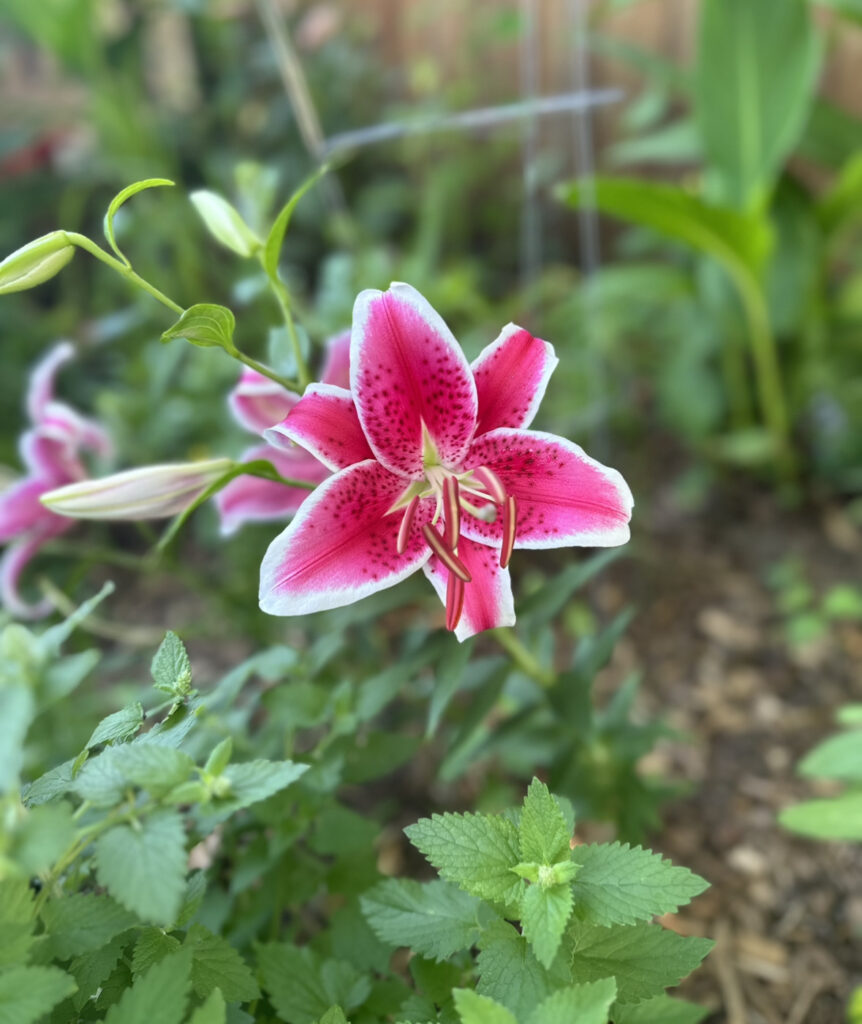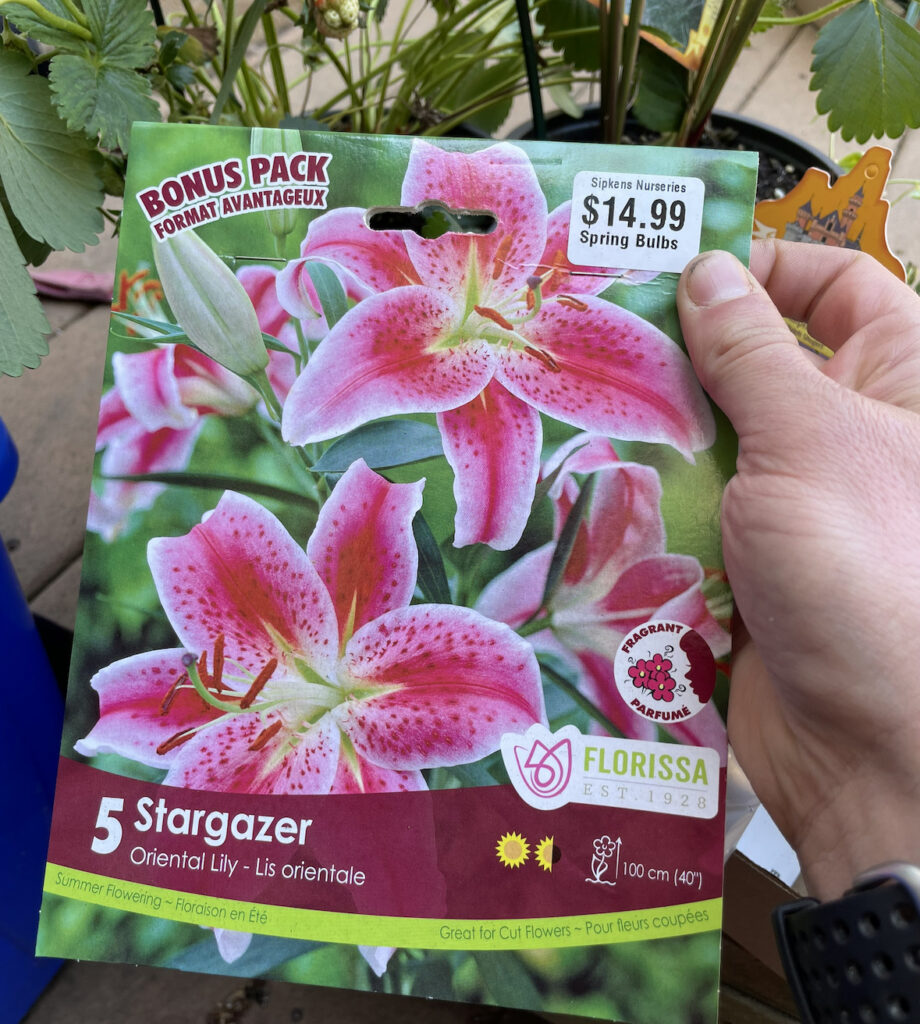The stargazer lily (Lilium ‘Stargazer’) is a captivating and popular hybrid lily known for its striking appearance and alluring fragrance. It is a member of the true lily genus, Lilium, and is renowned for its large, upward-facing flowers that exhibit a unique blend of vibrant colours and distinct markings.
Characterized by its impressive blooms, the stargazer lily typically features a mix of bold pinks, reds, and whites. The petals are elegantly curved backward, allowing the central stamens and pistils to be prominently displayed. Each flower usually has six petals, known as tepals, which are often adorned with dark pink or maroon speckles and spots, adding to its dramatic and eye-catching allure.

One of the most distinctive qualities of the stargazer lily is its intoxicating fragrance. The scent is strong, sweet, and often described as a blend of floral, fruity, and spicy notes. This fragrance has contributed to the popularity of the stargazer lily in various floral arrangements and gardens.
Stargazer lilies are perennial plants that can reach a height of about 2 to 4 feet (60 to 120 cm) when fully grown. They typically bloom during the summer months, adding a burst of color and elegance to gardens, landscapes, and floral displays. These lilies prefer well-draining soil and a location with full to partial sunlight.
Due to their captivating appearance and exquisite scent, stargazer lilies are commonly used in various floral arrangements, including bouquets, centerpieces, and decorative displays. They have become a symbol of beauty, purity, and admiration, making them a popular choice for weddings, celebrations, and special occasions.
It’s worth noting that while the stargazer lily is a beloved and widely cultivated hybrid, it can be toxic to cats. If you have feline companions, it’s essential to keep this in mind when choosing plants for your living space.
This page contains affiliate links, as an Amazon Associate, I earn from qualifying purchases at no extra cost to you. I will only ever post links to products I use and trust myself
Planting Stargazer Bulbs

In May I Picked up a pack of Stargazer Lilies from a local greenhouse. I planted them as soon as I got home, as fresh bulbs are the best to plant. They started to sprout within a few weeks, grew to about 18″ tall and at the beginning of August started to bloom. Here’s my guide on how you can grow your own at home.
How to Plant Lily Bulbs
Planting stargazer lily bulbs is a straightforward process that requires some basic gardening steps. The best time to plant stargazer lily bulbs is in the fall, typically between September and November. This timing allows the bulbs to establish their root systems before winter and bloom in the following summer. The second best time to plant them is early spring once the risk of frost is done. For us in Canada (Zone 6B) that time is around the first week in June.
Select a suitable location for your stargazer lilies. Choose an area that receives full to partial sunlight, as these lilies thrive in well-lit environments. The soil should be well-draining to prevent waterlogging, and the site should have good air circulation. Prepare the soil by digging a hole that’s about 6-8 inches (15-20 cm) deep. If you’re planting multiple bulbs, ensure you space them at least 12-18 inches (30-45 cm) apart to allow for proper growth. Adding compost or well-rotted organic matter to the soil can improve fertility and drainage.
When planting the bulbs, place them in the hole with the pointed ends facing up. This is where the shoots will emerge. Gently backfill the hole with soil, ensuring the bulbs are covered with about 3-4 inches (8-10 cm) of soil on top. After planting, water the bulbs thoroughly. This helps settle the soil around the bulbs and initiates the growth process. It’s important not to overwater, as excessive moisture can lead to bulb rot. Aim to keep the soil evenly moist, not soggy.

As winter approaches, apply a layer of mulch, such as straw or shredded leaves, around the planted bulbs. This protective layer helps shield the bulbs from extreme cold and temperature fluctuations during the winter months. It also serves to conserve moisture and prevent weed growth.
In the spring, as the weather warms up, you’ll start to see shoots emerging from the soil. Continue to water the plants regularly, especially during periods of dry weather. Once the shoots have grown a bit, you can apply a balanced, slow-release fertilizer to provide essential nutrients for healthy growth and blooming.
Depending on the height of your stargazer lilies, they might require support to prevent bending or breaking due to the weight of their heavy blooms. Stakes or other supports can be used to keep the stems upright.
With proper care and maintenance, your stargazer lilies should produce their stunning and fragrant blooms during the summer months. Regular attention, including watering, fertilizing, and removing spent blooms, will contribute to the long-term success of your stargazer lily plants as they continue to bloom year after year.

Fertilizing your Stargazer Lily
Fertilizing stargazer lilies is a crucial part of their care routine, as it supplies the necessary nutrients for their growth and vibrant blossoms. To fertilize your stargazer lilies effectively, follow these guidelines:
It’s essential to time your fertilization correctly. Apply fertilizer in the spring when the shoots start emerging, and then again after the blooming period has ended. Avoid fertilizing during the dormant winter months when the plants aren’t actively growing.
Select a balanced, slow-release granular fertilizer with a formulation like 10-10-10 or 14-14-14. These numbers represent the percentages of nitrogen (N), phosphorus (P), and potassium (K) in the fertilizer. A balanced fertilizer supports overall plant health and flowering.
If you’re looking for a simple well rounded fertilizer for your flowering plants, I usually go with Miracle grow Bloom Booster

Apply the fertilizer carefully around the base of the stargazer lilies. For spring fertilization, spread a thin layer of the granules while ensuring they don’t come into direct contact with the stems or leaves. After the blooming period, repeat this process using the same method.
After applying the fertilizer, water the plants to help dissolve the granules and allow the nutrients to reach the root zone. Maintain even moisture in the soil without causing waterlogging.
Avoid overfertilizing your stargazer lilies. They don’t require excessive amounts of fertilizer, and using too much can lead to problems like excessive vegetative growth instead of flowering, as well as potential nutrient imbalances.
If you prefer organic options, well-rotted compost, composted manure, or balanced organic fertilizers can be used. These alternatives release nutrients gradually and improve soil structure over time.
Always refer to the instructions provided on the fertilizer packaging for specific application rates and frequency recommendations. Different fertilizers might have varying guidelines.
Regularly monitor the condition of your stargazer lilies throughout the growing season. If you notice any signs of nutrient deficiencies such as yellowing leaves or poor growth, consider adjusting your fertilization routine or seeking advice from a local gardening expert.
In addition to proper fertilization, remember to provide your stargazer lilies with appropriate sunlight, water, and spacing to ensure their overall health and successful blooming.
Incorporating stargazer lilies into your garden or landscape can add a touch of elegance, beauty, and fragrance that few other flowers can match. Their stunning and unique appearance, marked by vibrant colours and captivating spots, draws the eye and sparks admiration. The intoxicating fragrance these lilies emit further enriches the sensory experience of your outdoor space. By growing stargazer lilies, you not only enhance the visual appeal of your surroundings but also contribute to the symbolism of purity and admiration that these flowers represent. Whether in floral arrangements, garden beds, or containers, stargazer lilies offer a timeless and enchanting presence that can truly transform your outdoor environment into a haven of natural splendor. Happy Gardening!

Leave a Reply